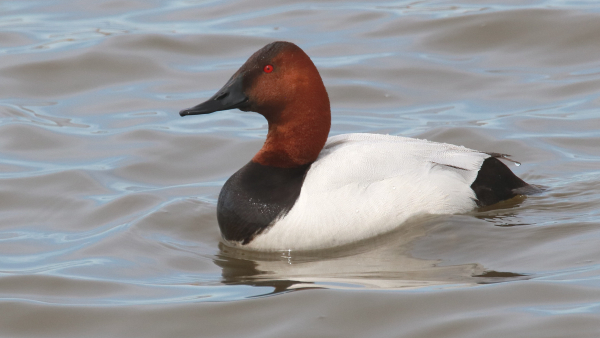
Canvasbacks must be the most regal ducks – and I’ve seen most species world-wide. There are more beautiful species, more agile species, rarer species; but the size and strength of Canvasbacks along with the males’ dramatic trio of colors that includes the hue of their velvety maroon neck and head makes them very impressive – along or in the company of other ducks. It may, however be the large, sloped head and bill that create a quickly identifiable silhouette, to say nothing of their fast direct flights. Canvasbacks are the kings of ducks to me, and they command my attention any time they are within photo range.
Getting within photo range is almost always the question though. Canvasbacks tend to prefer larger bodies of water where they spend their time far from the shoreline. They are also wary birds, so approaching them within the photo range of your lens is always a tough proposition. Periodically, I have good luck photographing a pair of Cans, but even then, they tend to be swimming away before providing a lucky turn to offer a side view in open water. But as far as getting some nice action photos of displaying males as they court a female, I’ve seen it from a distance, but I’ve never been able to photograph a drake displaying – until about 10 days ago.
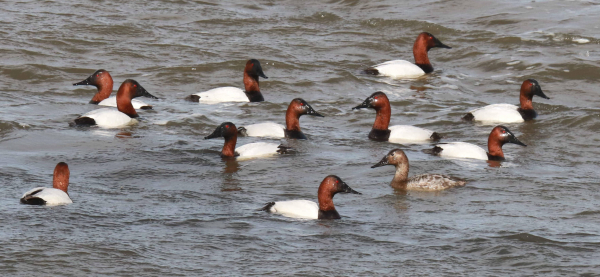
That’s when I was able to photograph a pair of Canvasbacks in beautiful light as they swam along the edge of some late ice – and that’s when the male began displaying with a couple “neck stretches” – a breakthrough photo op, although the female was quite a bit ahead of the displaying drake in the resulting photo.
Just a Few Moments
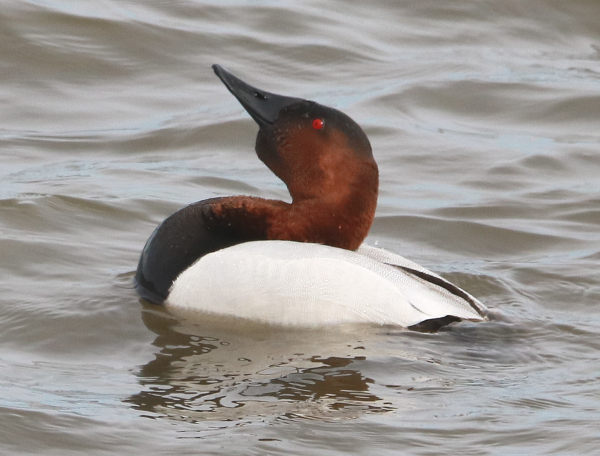
Zoomed in, this photo and the following image were taken of the same drake during a single “head throw” display, which must be the most impressive of Canvasbacks’ innate behavioral displays.

At the apex of the dramatic “head throw” display, the male swung its head and neck quickly backward until its bill pointed straight up with its neck on its back, but just for a second as it immediately flashed its head forward again. The action in these 2 images was stopped using an aperture of f8 with the resulting shutter speed at 1/1250.
|
A few days later, last Thursday to be exact, I thought I already had my prime photo opportunities of the afternoon having taken photos of a group of Bonaparte’s Gulls on the hunt just 20 minutes earlier. Certainly, it would be hard to improve on the beautiful water color and the effects of perfect sunlight; but there would be several more photo opportunities during the hours ahead. About 9 miles south of my office, on the edge of a lake that’s been popular among Canvasbacks this migration period, it was interesting to see a tight group of Cans within a few feet of the road – hmm.
I slowed my vehicle to a crawl and edged into position with the sun behind me and the hope of photographing the flock Canvasbacks, or at least a few individuals in close proximity. My eventual position was elevated from the big ducks, and they were at first hidden from view behind a short ledge – only 50 feet away. I had my lens focused on the area I expected the birds to appear, and braced the lens against the side of my window frame. I could hear the faint calls of the drakes, and time and again a single drake would reveal itself by backing into view, then slip back out of view below the ledge – hmm.
As my anticipation mounted, a female swam into view, beautifully colored in hues of silver and tan with the telltale romanesque slant to her profile. As she moved into view, so did 11 males, all focused on this female as they surrounded her in the water. Immediately, individual drakes began displaying – one stretching its neck, head, and bill high and slightly forward in a “neck stretch” display. Another male swung its head and neck briskly backward until its bill pointed straight up with its neck lying against its back – but just for a second as it immediately flashed its head forward again in a dramatic “head throw” display. Others followed suit as they performed for the female, while some males made a point to lunge forward to chase rivals, if only for a few watery feet.
Obviously, by this time I was in the thick of photographing the action before me, trying to anticipate which duck would display next. It was especially exciting to be in the midst of this Canvasback action – so close with the ducks displaying in disregard to my appearance on their spring stage. I was well aware of the novelty of this exciting opportunity, having watched similar mating activities from afar and wishing for a front row seat closer to the stage.
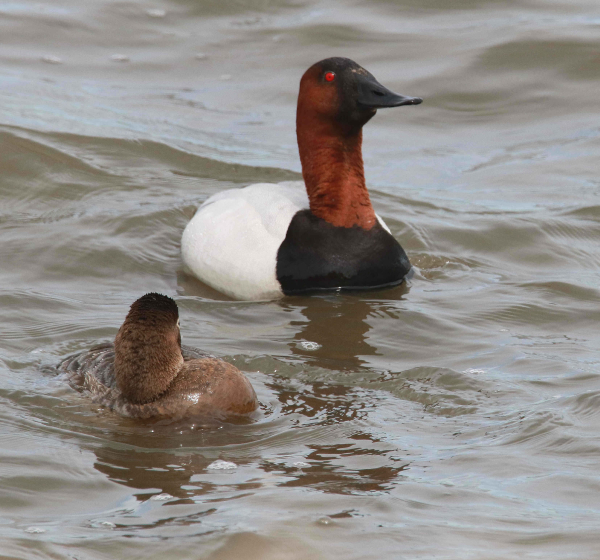
This drake performed a “neck stretch” display as it approached the indifferent female.
|
The surrounding males moved in concert with the female, and I followed the action as needed by relocating a few yards forward or back along the shoulder of the roadway. No cars passed, but I was always aware of the need to be positioned in a safe place. I also zoomed my lens in and out between taking portrait photos and images that included the flock.
One downside, however, was that soon after arriving the sun began to be filtered by advancing clouds – cloud cover that turned the sky and water a disappointing gray, a far cry from the icy blue water surrounding the Bonaparte’s Gulls earlier. Nonetheless, I stuck with the program and continued photographing under the ambient conditions, thrilled with the opportunity before me.
Diving In
Soon after the clouds arrived, the female Canvasback started a new line of activity when she began diving for extended periods of time. Immediately, the males followed suit, and at times only a couple were left above water. While wondering what it must look like below the surface, the female would pop back up, followed by drakes that showed some mud on the feathers near the base of their large bill. They were obviously feeding, perhaps on plant tubers or mollusks, and the process continued for an extended period. I feared the amorous displays were complete, but waited quite a while with high hopes.
In time, the Canvasbacks reassembled topside of their feeding area, only to be led away by the female. With a loud pattering takeoff, the flock took flight, and the female circled them back low, permitting me to take a documentary photo of the Canvasbacks in their mating flight taken with an aperture f8 at 1/2000 second shutter speed.
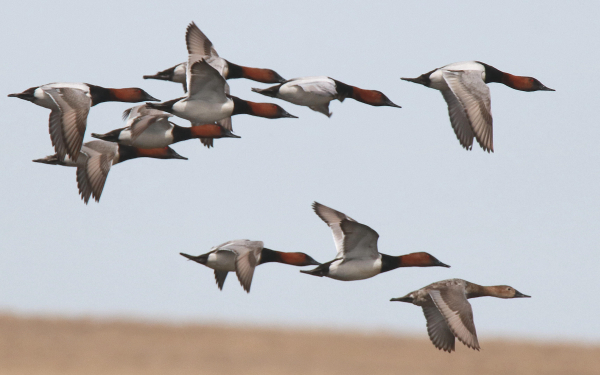
Timing
Aside from the flight foto, the other images were taken within the first 10 minutes of my arrival. If I had arrived 15 minutes later, I would have missed taking any photos of the ducks displaying. If I had arrived 15 minutes before I did, I may not have seen any displaying. Bird photography is often dictated by timing – by minutes, sometimes by seconds. Is it timing or luck when the birds and the light all come together? It’s often hard to differentiate between the two, but when the timing is right, go with the flow and make the most of the opportunity after making sure you are in the right location relevant to the direction of the sunlight.
At the same time, the water color and brightness of the plumage colors were diffused by the incoming cloudy conditions. Should I have arrived 20 minutes earlier? But I wondered, were the Canvasbacks positioned near the road then? And were they displaying? It’s probably not a good idea to rethink the situation too much. I did what I did, arrived when I arrived, made the most of the time I was there, and anything else is just speculation. I often say “timing is everything,” and often times it is; but in this case, I’m happy to have had the photo opportunities I had, wish the lighting was better, but that leaves room for improvement next time. Perhaps my little level of frustration is why I try to limit my photo efforts to periods with ample sunlight – and why I’m second guessing the situation.
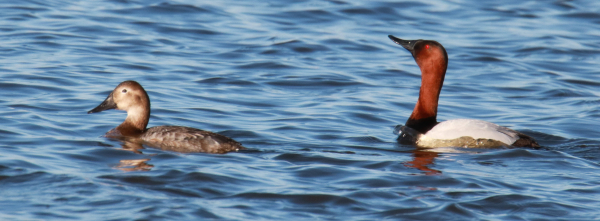
Spring is a season when photo opportunities increase by magnitudes, and I hope everyone takes advantage as new birds arrive and sunny days prevail. Good luck whenever you have your camera in hand.
Article and photographs by Paul Konrad
Share your bird photos and birding experiences at editorstbw2@gmail.com